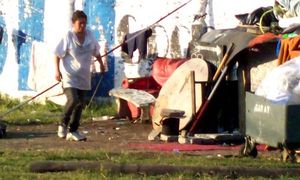by Dina Gonzalez
Global Press Institute
Although paco, a drug derived from cocaine, has a reputation of being a lower-class drug, it has extended to affect middle-class families as well. Families of people addicted to the popular street drug are demanding more state intervention, while authorities say families must take more responsibility for their drug-addicted loved ones.
BUENOS AIRES, ARGENTINA – “The living dead” haunt a street corner in Villa Zabaleta, a disadvantaged and dangerous neighborhood of Buenos Aires, the capital of Argentina. This is what neighbors call the drug addicts who wander the sidewalks of this intersection.
Some pedestrians can slip by these wanderers undetected. But if they register them passing by, the addicts ask for money. The bolder ones just rob them.

Thirty meters on the diagonal from the corner are tents made of cardboard and old blankets. One meter in height, the tents sit amidst old cartons, bags of trash and assorted junk.
Under one of these tents sits Paola Robledo, 33. Robledo has four children and one granddaughter. But she lives here alone.
Robledo is addicted to the drug “paco,” short for cocaine paste, a cheaper alternative to cocaine. So are two of her children, one of whom is a mother herself.
“What do you want to know, kid?” asks her mother, María del Carmen Robledo, 57, a thin woman with tan skin.
She lowers her head, takes a deep breath and continues talking.
“I am screaming for help for my granddaughters, for my grandson, Brian, and for my great-granddaughter,” says the older Robledo, who seems to have given up hope on her daughter.
The great-grandmother is energetic when she talks. The mother of five children, she raised them in Villa Zabaleta on her own after separating from her husband.
Her daughter who is addicted to paco has four children, ages 9, 13, 17 and 18. The two oldest, Micaela, who goes by “La Colo,” and Brian, are addicted to paco like their mother. Brian is in jail. La Colo has a 3-month-old baby, and they live in Villa Zabaleta with the older Robledo’s sister.
A judge assigned the younger Robledo’s third child to live with his godmother. The youngest lives with the older Robledo in a loaned house in Lomas de Zamora, a neighborhood in the province of Buenos Aires.
But the older Robledo returns to Villa Zabaleta every day to take her granddaughter to school. She also brings food to her daughter living in the tent and checks on how La Colo is doing.
Little by little, the great-grandmother shares how she raised her children in this marginalized neighborhood and worked long hours outside the home cleaning offices while her older children cared for the younger ones. She describes when she first realized her children consumed drugs and her failed attempts to find help.
“I asked them please don’t take up any ‘maña,’” she says, referring to vices. “Never in my life did I see my children taking drugs. I am so ignorant that I didn’t know that my children were high.”
She remembers one day when she saw her neighbor wearing her clothes. She found out that her daughter had sold her clothes to obtain money to buy drugs.
“I talked with Paola, but she denied it,” she says.
The older Robledo then decided to take care of her daughter’s children.
“I didn’t want my grandchildren going from one place to another,” she says. “More than one person from the neighborhood gave drugs to Paola because they wanted to keep her kids. I tried to talk to her, to explain to her that the kids here didn’t lack anything.”
She also got her daughter a job cleaning with her. But it didn’t go well.
“She embarrassed me,” she says. “She ate the other employees’ food. It was as if she were dying of hunger!”
She still remembers what her boss said to her.
“‘María, I know that you have the will, but your daughter is hopeless,’” she says her boss told her.
In search of solutions, she went to a civil court and filed for Protection of Person, which permits families to admit adults for care against their will. This way, she could admit her daughter into a rehabilitation facility even though she was no longer a minor. But her daughter didn’t stay long and returned to her old ways.
At this time, the older Robledo became sick with cancer. She recovered, but she couldn’t take care of everything as she used to. Finally, she put her grandchildren under the custody of the state. But she says its response was lacking.
“They didn’t help me with anything,” she says of the state. “I asked them for the environmental certificate, and they told me they couldn’t come.”
This would have required specialists to evaluate the children’s living situation, in a house in Villa Zabaleta with their paco-addicted mother at the time. She says she wanted to demonstrate that this wasn’t a suitable place for her grandchildren to live and that they needed help.
But she says the specialists didn’t want to come to the neighborhood because it’s dangerous. Instead they asked her to come to the court.
“They told me, ‘How beautiful they are,’ they patted me on the back, and they left,” she says. “I asked them for the environmental certificate for Paola, but they didn’t come either. If they had done the follow-up, maybe Paola wouldn’t be how she is.”
The younger Robledo suddenly leaves her tent and walks down the street. Her mother knows she’s coming, but she doesn’t look up at her or say anything. The daughter also knows her mother is there, but she doesn’t come near or look her way. She continues down the street, with neither of them acknowledging each other.
“She is in her own world – she’s ‘limada,’” her mother says, meaning that her daughter’s brain is fried. “She doesn’t understand anything.”
She says that her grandchildren started to do drugs when they started high school. She asked for the school’s help in intervening but without success.
“It was the worst thing I did in my life enrolling them in high school,” she says.
The years passed, and Robledo says that she’s lost the strength to fight. The death of one of her children in 2010 in an accident made her sense of hopelessness even heavier.
“He was my support,” she says of her deceased son. “I don’t want to fight anymore.”
The great-grandmother keeps talking, but she ends up in tears.
“The neighborhood doesn’t have anything bad,” she says. “I raised my kids here, and they didn’t all end up like this. These are things that they put in kids’ heads. They grow up, and, as that shitty law says, no one can do anything.”
Paco is a cheaper version of pure cocaine that carries the reputation of being a lower-class drug. But after emerging in humble neighborhoods like Villa Zabaleta, it has extended to higher social classes as well. Families with members addicted to paco demand that the state intervene by drafting public policies to assist them and to contain the pervasive problem, but the state delegates this responsibility to families. Authorities say they are overwhelmed, as other organizations strive to fill in the gap in services.
Paco has the appearance of a white or yellowish dust. Consumers smoke it in pipes or mix it in a cigarette with tobacco or marihuana. The homemade pipes they make with TV antennas, empty pens or cans riddled with holes.
Alicia Romero, president of Mothers Against Paco, a nongovernmental organization, says that there are no official statistics on Argentines addicted to paco because the issue is not important to authorities.
“The kids don’t matter to them,” she says. “What statistic is it going to be if the police stop them, take the drug from them and let them go?”
But the Secretaría de Programación Para la Prevención de la Drogadicción y la Lucha Contra el Narcotráfico launched in 2006 the Estudio Nacional Sobre Consumo de Sustancias Psicoactivas. The study revealed that 0.5 percent of the local population, some 85,000 people, had recently consumed a cocaine base paste. The consumption of this substance is greater among males than females and among the age group of 12 to 24.
Romero says that the substance began to become popular in Argentina after the 2001 economic crisis here.
“It’s the drug of the poor,” she says, explaining that it originally began to install itself in marginalized neighborhoods called “villas miseria” and gained the reputation of being a lower-class drug.
But she says that addiction to paco is not a patrimony unique to this class or to the poor. Paco has also invaded middle-class homes, where families fight to save their children from this highly addictive drug.
Such is the case of Mabel, who asked to be referred to by her middle name to avoid the social stigma of people knowing that her son Darío is addicted to paco.
Mabel is a middle-class professional who holds a recognized position in the Buenos Aires city government, attending to social issues. She has three children and is divorced from their father, a lawyer.
“No one knows anything,” she says, explaining that few family members and friends know about Darío’s addiction.
She recalls a particular incident that happened a few months ago. It was 2 a.m. when she woke up to the sound of the entry phone ringing incessantly. It was her other son, who had returned from a barbecue and found Darío lying on the sidewalk, unconscious. Darío had jumped from the second floor, in an attempt to escape from the house in order to buy paco.
Like the older Robledo, Mabel says she also completed the Protection of Person process in court and was able to admit Darío, who is in his 20s, into a rehabilitation center. She says it wasn’t easy because he didn’t want to go to the private clinic. She had to trick him and when he realized, he yelled insults at her such as, “You are the worst mother,” and “I didn’t imagine that you were going to lock me up.”
The admission didn’t last long. After, Darío returned the same.
Mabel says that prepaid medical insurance companies don’t cover people with addiction backgrounds, with all treatment costs falling on the families. She therefore tricked her insurance company by passing her one son off as the other in order to get Darío’s treatment covered.
“I sent my other son, who passed for Darío,” she says.
She says the situation has been improving.
“Now he’s more controlled,” Mabel says of her son.
A psychiatrist comes to their house every 15 days, which costs 400 pesos ($90 USD). But she says she can’t do much more to intervene.
“It’s difficult,” she says. “There’s no other thing to do. He is above age, and the law says that if he doesn’t want to, one can’t make him do anything.”
To confront this issue, the federal government created Centros Provinciales de Atención en Adicciones, provincial outpatient facilities for people with addictions. The autonomous city of Buenos Aires has a similar system, with two outpatient centers called Casa Flores and Casa Puerto.
But they have open-door policies. When the patients want to leave, they are free to leave. Moreover, many say these initiatives aren’t sufficient to attend to the growing population of drug addicts.
In the face of this insufficiency have surged various social organizations such as Mothers Against Paco, the most popular to date.
Romero is the coordinator of this organization in the southern zone of the province of Buenos Aires. Her office is located in Lomas de Zamora, the locality where the older Robledo lives.
She says that the network was born out of necessity, in order to orient mothers in the fight for help for their children who are addicted to drugs. She says that authorities need to better publicize the rights that drug addicts and their families have to attain help.
“We help the mothers so that they don’t [give them a hard time],” she says, mentioning the challenges they face at hospitals and in courts. “The mothers don’t know where to go and what their rights are.”
She cites judicial inaction and a lack of commitment on the part of the state. She urges the government to create public policies that function in practice. She also denounces the discrimination of public hospitals against drug addicts and cites a lack of staff.
Lawyer Gabriela Silva Alpa, an official in the Defensoría de Niños, Niñas y Adolescentes in Pompeya, a local office of the city government’s Consejo de los Derechos de Niños, Niñas y Adolescentes, recognizes the lack of staff in hospitals. But she assures that workers at public health centers do whatever they can to attend to addicts.
“They put on the shirt – they do all the work,” Alpa says.
Lawyer Silvia Vaccaro, coordinator of this office of the Defensoría, adds that the institution is overwhelmed by the paco problem and lacks the sufficient personnel to comfort and check in on the addicts’ families.
“We have three family operators in three neighborhoods,” she says. “What can one do? One does what they can.”
She says that families need to take more responsibility.
“Moreover, the families arrive and want an obligatory admission,” she says. “That shouldn’t be the stance: Grab the kid, admit him or her, and I get rid of the problem. Social politics of addiction don’t exist. One has to work the bond of the family.”
But Romero explains that in the case of the middle class, there’s a new edge to the problem. Many times, families in this class don’t look for help, perhaps for fear of the embarrassment that it may generate to have a drug addict in the family.
“Those mothers don’t come near,” she says. “Maybe because of embarrassment. It’s not easy. It’s maybe because of the prejudice that exists if this is a problem that emerges in the family.”
Romero highlights the existence of a new law that contemplates the possibility of admitting addicts who are above age who don’t want to be hospitalized. Under the National Mental Health Law No. 26657, a law sanctioned in November 2010, “The involuntary admission of a person should be considered an exceptional therapeutic resource in the case that outpatient approaches aren’t possible, and only will happen when the criteria of a health team mediates the situation of certain and imminent risk for the addict or for third parties.”
According to the law, the situation of risk must be vouched for by two professionals of different disciplines who are not linked to the addict personally or economically, among other requirements.
The story was originally published by Global Press Institute. (c) Global Press Institute 2012




